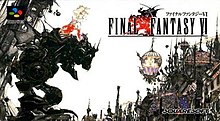
Back فاينل فانتسي 6 Arabic فينال فانتاسى ڤى (فيديو لعب) ARZ Final Fantasy VI Catalan Final Fantasy VI German Final Fantasy VI Spanish Final Fantasy VI Estonian Final Fantasy VI Basque فاینال فانتزی ۶ Persian Final Fantasy VI Finnish Final Fantasy VI French
| Final Fantasy VI | |
|---|---|
 Box art of the original Super Famicom (Japanese) release | |
| Developer(s) | Square |
| Publisher(s) | Square
|
| Director(s) | |
| Producer(s) | Hironobu Sakaguchi |
| Designer(s) | Hiroyuki Ito |
| Programmer(s) | Ken Narita |
| Artist(s) |
|
| Writer(s) |
|
| Composer(s) | Nobuo Uematsu |
| Series | Final Fantasy |
| Platform(s) | |
| Release | April 2, 1994
|
| Genre(s) | Role-playing |
| Mode(s) | Single-player |
Final Fantasy VI,[a] also known as Final Fantasy III from its initial North American release, is a 1994 role-playing video game developed and published by Square for the Super Nintendo Entertainment System. It is the sixth main entry in the Final Fantasy series, the final to feature 2D sprite based graphics, and the first to be directed by someone other than series creator Hironobu Sakaguchi; the role was instead filled by Yoshinori Kitase and Hiroyuki Ito. Long-time collaborator Yoshitaka Amano returned as character designer and concept artist, while composer Nobuo Uematsu returned to compose the game's score, which has been released on several soundtrack albums.
Set in a world with technology resembling the Second Industrial Revolution, the game's story follows an expanding cast that includes fourteen permanent playable characters. The narrative deals with the themes of a rebellion against an immoral military dictatorship, pursuit of a magical arms race, use of chemical weapons in warfare, depictions of violent and apocalyptic confrontations, several personal redemption arcs, teenage pregnancy, and the renewal of hope and life itself.
Final Fantasy VI received widespread critical acclaim, particularly for its graphics, soundtrack, story, characters, setting, and mature themes, and won numerous awards. It is widely considered to be one of the greatest video games of all time, and is often cited as a watershed title for the role-playing genre. The game was a commercial success, with the Super NES and PlayStation versions selling over 3.48 million copies worldwide by 2003, as well as over 750,000 copies as part of the Japanese Final Fantasy Collection and the North American Final Fantasy Anthology.
It was ported by Tose with minor differences to the PlayStation in 1999, and the Game Boy Advance in 2006. The Super NES version was rereleased for the Wii's Virtual Console in 2011, and by Nintendo as part of the company's Super NES Classic Edition in 2017.[1] The game was known as Final Fantasy III when it was first released in North America, as the original Final Fantasy II, III, and V had not been released outside Japan at the time (leaving IV as the second title released outside Japan and VI as the third). However, all later versions of the game, other than re-releases of the original version, use the original title.
Cite error: There are <ref group=lower-alpha> tags or {{efn}} templates on this page, but the references will not show without a {{reflist|group=lower-alpha}} template or {{notelist}} template (see the help page).
- ^ "Super NES Classic Edition". Nintendo of America, Inc. September 29, 2017. Archived from the original on September 28, 2017. Retrieved January 25, 2021.
© MMXXIII Rich X Search. We shall prevail. All rights reserved. Rich X Search